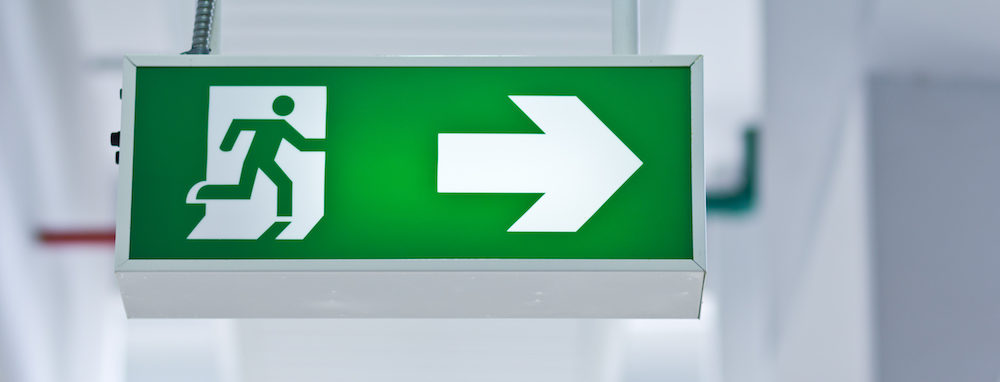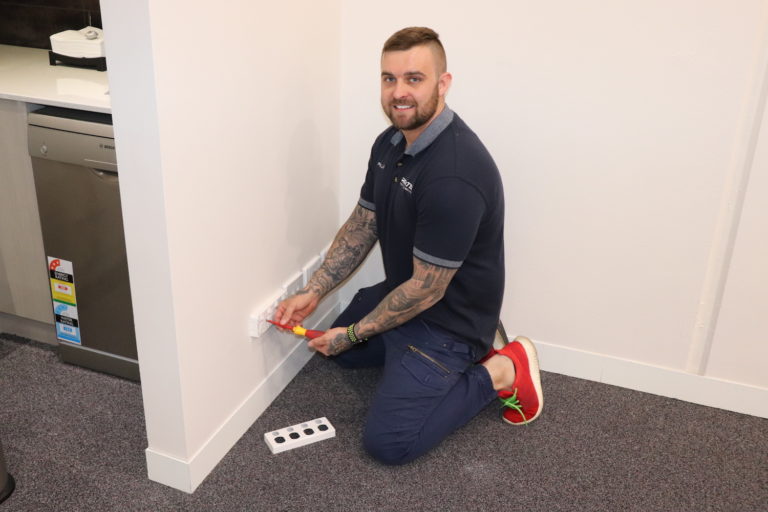
In the chaos of an emergency situation, it can be extremely difficult to know which way to go, and this is especially true if you are in an unfamiliar place. Having emergency exit lighting is important for helping all building occupants find their way to the exit and out to safety. These types of electrical lighting aren’t simply a thoughtful aid; they can quite literally save lives. Emergency and exit lighting is often a requirement mandated by the Building Code of Australia, US Building Codes, and many other regulatory bodies. Sometimes, laws and regulations can be difficult to understand comprehensively. If you own or manage a building, how can you know if your building requires emergency and exit lighting under the law? And if it is required for your building, how can you be sure what types of lighting are compliant with the law? There’s plenty of detailed information given by the Building Code of Australia, but here we’ve tried to condense and simplify all of that information so you can make better use of it. Below you’ll find a list of criteria regarding emergency and exit lighting, and this information will help you stay abreast of the law as well while also helping you keep your guests safe.
Does Your Office Need Emergency and Exit Lighting?
This is a bit of a loaded question since the answer is dependent on many variables like building size, amount of natural light, and even how the building is used. Since we cannot see the space you are referring to, we’ll outline a series of general requirements so that you should be able to easily determine the answer for yourself with your knowledge of the space.
Floor Area
If the floor area of the space in question is less than 300m 2 , you might not need emergency and exit lighting, but even this is dependent upon the class of building in question. Keep reading for more on that. However, if the floor space of the building in question is greater than 300m 2 , emergency and exit lighting is always required by law, and lighting must be properly installed. In a large area it can be even tougher to pick your way to safety should an emergency arise, so having illuminated emergency exit signs is a great help.
Natural Light
The Building Code of Australia requires that if the exit from any room does not open into a space with adequate natural light, there must be emergency and exit lighting installed within that room. How do you determine what adequate natural light is, though? Well, if the building is lined with glass, chances are there’s plenty of natural light streaming in allowing you to see your way out in an emergency. However, if the door to the room you are in opens into a hallway or into another room not exposed to natural light, there won’t be enough natural light and you’ll need emergency and exit lighting instead. Building residents need to be able to find their way out even if it’s dark or the power is down. This means that if there’s inadequate natural light for this purpose, you need to get some electrical lighting installed.
Building Class
Do you know what class your building is? This classification is a part of the building code, and should be indicated on various paperwork. If you’re the manager or owner, you should be aware of this classification. If you’re unsure, you need to find out. The building class also influences whether or not your building needs to have emergency and exit lighting. If the building in question is a Class 5, 6, 7, 8 or 9, each storey of the building must have emergency and exit lighting properly installed to comply with the BCA’s requirements. Any room with a floor area exceeding 100m 2 which doesn’t open onto a space where emergency and exit lighting has already been installed must have this lighting installed within the room itself. Also, any room on any floors that measures more than 300m 2 must also have emergency and exit lighting installed. Any closed-off offices or other enclosed areas must also have emergency and exit lighting installed.
Passageways and Stairways
Any hallway, corridor or passageway more then 6m from the entrance doorway must have emergency lighting installed. In your building, every fire-isolated passageway, fire- isolated ramp and fire-isolated stairway must also have emergency and exit lighting installed. Non fire-isolated stairways are sometimes also required to have electrical lighting. External balconies that lead to fire-isolated stairways, ramps or passageways must have emergency lighting, and external stairways used in place of fire-isolated stairways must also have this electrical lighting installed. For safety’s sake, all stairwells and passageways should have safety lighting installed. This lighting should not only clearly indicate where the exits are located but should also illuminate the way through the building, and stairs and ramps clearly visible.
Public Access
If your building allows public access to any room, office or other space within the building, there are laws regarding emergency and exit signs for this as well. If your building is a class 6 or 9b building, there must be electric lighting for emergencies and exits if there’s a distance of more than 20m from the nearest doorway to an exit to a stairway, ramp, open space or passageway. If your building is a class 9a health care facility, there must be emergency and exit lighting in every passageway leading to a treatment area, in every room with more than 120m 2 of floor area, and in every patient area.
Additional Requirements
Building on the above requirements and laws, the Building Code of Australia has other guidelines regarding electrical lighting that must be met in order to comply with the law. All of the exit signs within your building must always be illuminated. Every single emergency exit needs to be marked plainly with an illuminated exit sign, and these signs should be visible wherever you are in the building. All emergency and exit signs need to remain illuminated if a blackout occurs. If you are not sure if your lights comply, be certain to hire a licensed electrician to inspect the lights for this purpose. You also need to make sure there’s nothing blocking the exits. In case of an emergency, you do not want people to be trapped inside the building because a pile of boxes is blocking the only way out of the room. There must be a clear path to all exits so all occupants can exit safely. If there’s any chance the exits could become blocked, you need to place signage reminding people that there needs to be no obstruction of the emergency exits.
Maintaining Your Emergency and Exit Lighting
Once you have the lighting installed and you meet the Building Code of Australia’s requirements regarding this type of lighting, you need to be diligent in maintaining your electrical lighting system to ensure it is functioning properly. If you manage or own a building, you need to take full responsibility for the safety of the people within the building, whether occupants or employees. If your emergency lighting is not working properly and an emergency does occur, it could be extremely dangerous for the people within the walls of your building. You should regularly check the condition of all emergency and exit lighting throughout your building. To be safe, schedule a maintenance check once or twice a year. Schedule an appointment with a licensed electrician to do the job. They can inspect the electric lighting to be sure it’s free of defects and is functioning properly. If any problems arise with the lighting system, you’ll already have an electrician familiar with it on hand to carry out servicing. Not only s regular maintenance good for keeping the system functional, most places require this as a standard. Businesses must keep records containing when servicing is carried out, who is doing the servicing, and a note of any problems found.
Other Considerations
Even if your building is small enough (less than 300m2 of floor area) or has enough natural light not to warrant emergency and exit lighting by law, you might still think about getting it installed anyway. It can give many of your patrons, customers, and guests peace of mind knowing where they can go should an emergency arise.
Final Word
Emergencies can happen quickly and with no warning. Should an emergency arise while the building is full of people, they need to be able to find their way safely out of the building. If there’s a fire and the lights have been knocked out and smoke is billowing, having permanently illuminated emergency and exit signs can save lives by directing people out of harm’s way. Any building owner or manager needs to have a well-considered safety plan for their building and the people within it. A vital part of this safety plan is the emergency and exit lighting, and this plan needs to meet the most recent standards that have been set forth by regulators. Get in touch if you need any of this clearing up. We’re always more than happy to help.
















